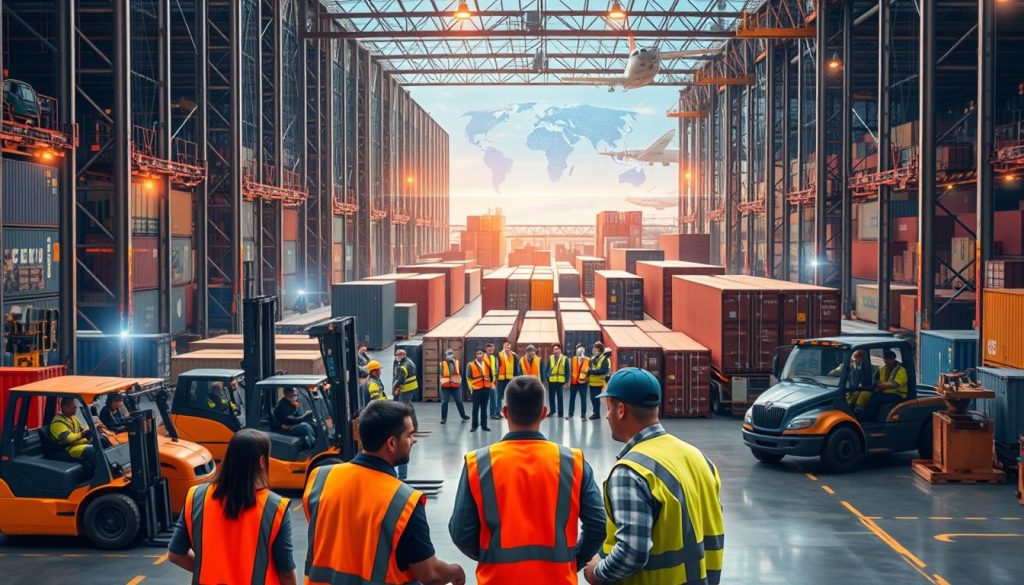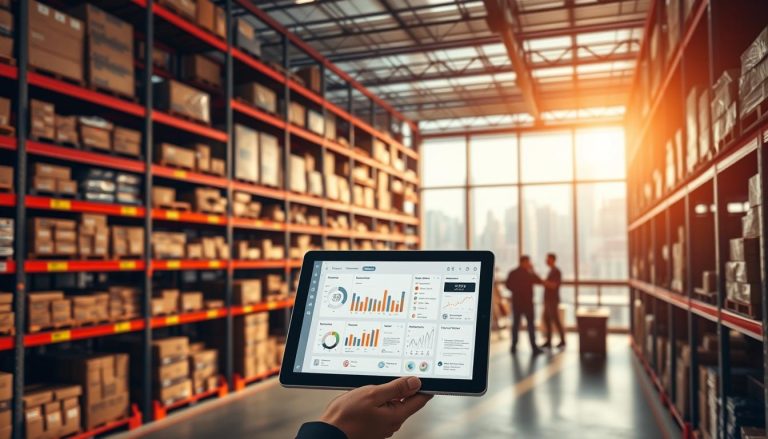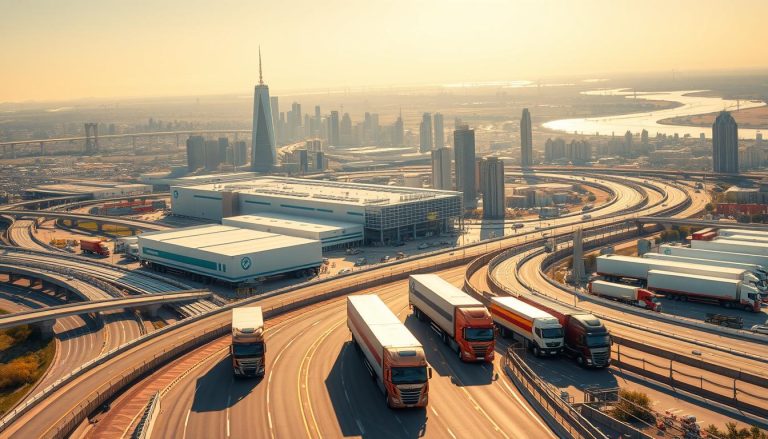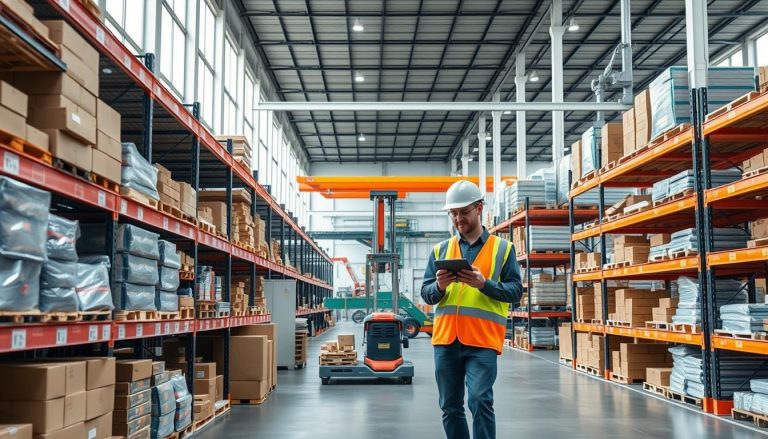What is Logistics? Understanding Its Role & Impact
Logistics is the backbone of the U.S. economy and our daily lives. It ensures goods, services, and information move efficiently from production to consumption. Understanding logistics is key to grasping its significance: it’s the network that connects transportation, warehousing, inventory, packaging, order fulfillment, and distribution.
Without logistics, stores would quickly run out of stock, factories would halt production, and hospitals would face critical shortages. This highlights the critical role of logistics in our society. Efficient logistics systems reduce delivery times, lower costs, and enhance customer satisfaction in retail, manufacturing, and healthcare.
The rise of globalization and e-commerce has made logistics more complex. Cross-border trade introduces additional regulations, multiple stakeholders, and different time zones. Today’s logistics relies on real-time analytics for better visibility and control. Companies like Amazon and Alibaba are leading the way with robotics, automation, and AI to improve efficiency and speed.
This section offers a concise logistics overview for those making strategic decisions. It views logistics as a data-driven discipline that boosts competitiveness and resilience. Effective logistics execution transforms supply chains into strategic assets, even in uncertain markets.
Logistics Overview: Definition, Meaning, and Core Concept
In today’s commerce, a thorough logistics overview is key for making decisions on cost, speed, and service. Executives rely on this framework to weigh options that impact cash flow, inventory turnover, and delivery reliability in the U.S. and worldwide.
Logistics definition and logistics meaning
The logistics definition highlights the planning, execution, and management of efficient, cost-effective goods and service flows from origin to consumption. It encompasses packaging, warehousing, inventory management, transportation, and order fulfillment.
In essence, logistics revolves around turning demand into physical movement with precise data and timely action. Companies like UPS, FedEx, and Maersk use standardized processes and service metrics to maintain consistent flows.
The classic goal: right product, place, time, condition, and cost
The classic goal sets the daily agenda: ensuring the right product, place, time, condition, and cost. This objective shapes network design, carrier choice, and inventory strategies, balancing lead time with working capital and risk.
Teams apply this principle to test modal mixes, packaging, and reorder points to avoid stockouts and excess. This approach creates a service profile that meets budget and performance goals.
Logistics explanation within the broader supply chain
Logistics acts as the backbone of the supply chain, connecting suppliers, manufacturers, distributors, and consumers. It turns plans into shipments, receipts, and storage moves, influencing lead times and service quality.
As companies operate across multiple countries, time zones, and customs, logistics ensures compliance and continuity. This core operation maintains flow, reduces variability, and supports growth in complex networks, adhering to the logistics overview and its practical objectives.
Historical Roots to Modern Networks
The concept of logistics has grown from the chaos of battlefields to the precision of today’s boardrooms. It’s about the coordinated movement, storage, and data flow that shapes costs and services. This evolution highlights the critical role of logistics in maintaining resilient supply chains.
From military origins to commercial sophistication
Military campaigns, from Napoleon to World War II, showed the importance of timing, routing, and provisioning. These disciplines have been adopted by civilian networks today. Now, companies use standardized processes, multimodal transport, and inventory controls.
This evolution includes the use of queue management, cross-docking, and demand-driven replenishment. It shows how logistics aligns capital, capacity, and service levels.
Globalization, e-commerce, and rising complexity
As sourcing expanded across North America, Europe, and Asia, logistics had to adapt to customs, sanctions, and trade compliance. Today, routing balances tariffs, lead times, and geopolitical risks.
E-commerce has introduced tighter delivery windows and expanded returns. Parcel networks now use micro-fulfillment and regional sorting sites to handle spikes. This shift highlights the growing importance of logistics in urban and suburban markets.
How companies like Amazon and Alibaba use robotics and AI
Amazon employs mobile robots, robotic arms, and automated sortation to reduce travel time and errors. Machine learning predicts demand, while dynamic routing optimizes last-mile delivery. This approach enhances service speed and density.
Alibaba’s Cainiao uses automated guided vehicles, computer vision, and AI planning for its national networks in China and cross-border flows. These technologies showcase the scale, precision, and reliability of logistics under peak loads. They demonstrate the logistics concept in action.
What is Logistics?
Many professionals seek clarity on what logistics entails in operational terms. It involves coordinating the movement and storage of products, services, and data to fulfill customer needs efficiently. A detailed logistics overview helps in defining roles, managing risks, and fostering growth.
Logistics bridges strategy and execution. It leverages demand signals, carrier capacity, and warehouse efficiency to strategically place inventory. Metrics such as on-time delivery and lead-time variability guide daily operations.
Planning, implementing, and controlling flows of goods, services, and information
Logisticians plan everything from purchase orders to transportation routes. They implement these plans using services from UPS, FedEx, Maersk, and BNSF. They then monitor and adjust these plans through management systems and audits.
A robust logistics overview encompasses network planning, order management, and quality assurance. It ensures that sales forecasts align with available capacity and labor, maintaining service consistency during demand fluctuations.
End-to-end scope: origin to consumption across modes and nodes
The scope of logistics spans from suppliers and factories to retail stores and consumers. It involves various modes like road, rail, air, and sea, and nodes such as ports, cross-docks, hubs, and warehouses. This framework is essential for companies like Walmart, Apple, and Target.
Real-time visibility is key, tracking shipments from origin to final delivery. Data from GPS, EDI, and barcode scans is used by control towers for proactive issue resolution.
Balancing cost, speed, reliability, and service levels
Choosing the right mode of transport is a delicate balance. Air transport offers speed, while ocean transport provides scale. Intermodal solutions aim to balance cost with stability. Policies dictate safety stock levels, order cycles, and cut-off times to maintain service standards.
Network design, carrier selection, and fulfillment strategies are critical. A practical logistics overview demonstrates how small adjustments can significantly improve margins without compromising on delivery times. This reflects the core of logistics in today’s operations.
Logistics Functions That Power Supply Chains
Core logistics functions turn plans into reliable flow. This logistics overview shows how teams use logistics basics. They move goods quickly, manage risks, and protect profit margins across all networks.
Transportation management across road, rail, air, and sea
Transportation management picks the best mode for each route. It considers transit time, total cost, reliability, and cargo traits. Road offers flexibility for local routes, rail is best for bulk, air is fast for high-value goods, and sea is cost-effective for long distances.
Teams optimize routes and schedules, combine loads, and negotiate with carriers. Tools like SAP and Oracle’s transportation management systems reduce empty miles and boost on-time delivery.
Warehousing, inventory management, packaging, and order fulfillment
Warehousing keeps products safe and supports efficient picking and packing. Layouts use slotting and ABC velocity to cut travel time and increase throughput. Packaging ensures product integrity, meets safety standards, and supports traceability.
Inventory management aims for the right balance between stockouts and excess. Planners use safety stock, reorder points, and service-level targets based on demand. Order fulfillment aligns with retailer scorecards from Walmart, Target, and Amazon.
Demand planning, distribution, and last-mile delivery
Demand planning uses statistical forecasting and POS signals to set volume expectations. It synchronizes supply with demand. Distribution strategy positions inventory to compress lead times and smooth variability.
Last-mile delivery manages the most critical and costly segment. Route sequencing, micro-fulfillment, and delivery windows meet e-commerce promises. They protect unit economics and customer experience.
| Function | Primary Objective | Key Levers | Performance Metrics | Typical Technologies |
|---|---|---|---|---|
| Transportation Management | Minimize transit time and total landed cost | Mode mix, route optimization, load consolidation | On-time delivery %, cost per mile, tender acceptance % | TMS, eBOL, ELD telematics, dynamic pricing tools |
| Warehousing | Protect inventory and accelerate throughput | Slotting, wave/batch picking, dock scheduling | Lines picked per hour, dock-to-stock time, damage rate | WMS, automated storage, voice picking, RFID |
| Inventory Management | Balance service with working capital | Safety stock, reorder points, multi-echelon planning | Fill rate %, days of supply, inventory turns | MEIO, ERP planning modules, demand sensing |
| Packaging | Ensure product integrity and compliance | Right-size cartons, protective materials, labeling | Damage claims %, cube utilization %, compliance score | Cartonization engines, barcode/GS1 systems |
| Order Fulfillment | Ship accurate orders at speed | Pick strategies, QA checks, carrier selection | Perfect order rate %, cycle time, cost per order | OMS, parcel manifesting, automated sortation |
| Demand Planning | Align supply with forecasted demand | Statistical models, POS signals, collaborative planning | Forecast accuracy, bias, service level | APS suites, machine learning forecasting |
| Distribution & Last Mile | Compress lead times and meet delivery windows | Hub placement, cross-docking, route sequencing | Lead time, cost per stop, first-attempt delivery % | Network design tools, route optimization, POD apps |
The Everyday Impact of Logistics on Consumers and Communities
Daily access to food, apparel, and electronics relies on synchronized transport, storage, and demand planning. A clear logistics overview shows how routing, temperature control, and inventory policies protect product quality while containing cost. For households and cities, logistics importance appears in stocked shelves, predictable delivery times, and stable prices built on a rigorous logistics concept.
From coffee beans to store shelves: a real-world journey
Consider coffee sourced from Colombia and shipped to the United States. Beans move from farms in Huila to dry mills in Bogotá, then to the Port of Cartagena, with export documents and quality checks aligned to the logistics concept.
After ocean transit to the Port of Miami or Port of New York and New Jersey, roasters such as Starbucks and Peet’s manage roasting schedules and packaging to match demand.
Distribution centers near Atlanta, Chicago, and Los Angeles stage inventory for grocers like Kroger and Costco. Forecast accuracy and lead-time buffers preserve freshness while avoiding spoilage. This trackable path illustrates logistics importance in cost control and product availability within a full logistics overview.
Keeping hospitals supplied with critical equipment and medicines
Health systems depend on time-definite deliveries for ventilators, surgical kits, and temperature-sensitive vaccines. Distributors such as Cardinal Health and McKesson plan cold-chain routes, monitor sensors, and audit carriers to meet FDA and USP standards. The logistics concept here prioritizes condition and traceability alongside speed.
Urban and rural clinics require resilient replenishment to absorb demand spikes. When transport lanes are disrupted, safety stock and alternate nodes limit delays. These safeguards show logistics importance to patient care and community health, supported by a precise logistics overview of lanes, nodes, and contingencies.
How logistics availability sustains retailers and manufacturers
Retailers rely on steady inbound flows to prevent stockouts across peak seasons. Walmart and Target balance cross-dock throughput, last‑mile capacity, and store-level allocations to maintain service levels. For manufacturers, inbound steel, resins, and semiconductors feed plants running just-in-time schedules, while outbound finished goods move through regional hubs to wholesalers and dealers.
When availability falters, carrying costs rise, promotions miss targets, and production lines risk idling. Stable freight networks, accurate ETAs, and slotting discipline reflect the logistics concept at work. This is the practical logistics overview that supports jobs, sales, and reliable access to essentials, affirming logistics importance for households and local economies alike.
Technology and Innovation Driving Efficiency
Modern networks thrive on accurate data and swift responses. A detailed logistics overview reveals how visibility and automation reduce lead times and waste. It showcases tools that enhance efficiency across carriers, warehouses, and ports, aligning with digital logistics strategies.
Real-time tracking, sensors, and GPS for end-to-end visibility
Carriers use GPS, IoT sensors, and telematics to track location, temperature, shock, and door events. This live data enables dynamic rerouting around weather or congestion, speeding up exception handling. Platforms like those used by UPS, FedEx, and Maersk send updates to shippers and buyers, boosting on-time performance and inventory accuracy.
Automation and robotics in warehouses and distribution centers
Robotic arms, automated guided vehicles, and goods-to-person systems minimize manual errors. Amazon and Ocado employ mobile robots to enhance picking and stock replenishment, increasing lines-per-hour and space use. Automation also standardizes quality checks and supports safer, ergonomic workflows during peak periods.
AI, data analytics, and blockchain for optimization and trust
Machine learning predicts demand, sets safety stock, and optimizes routes under fuel and capacity constraints. It also forecasts maintenance needs, reducing downtime for conveyors and lift trucks. Blockchain ledgers from IBM and Maersk’s TradeLens create shared, immutable records, verifying provenance, authenticity, and compliance across partners.
| Capability | Operational Benefit | Key Metrics Affected | Representative Uses |
|---|---|---|---|
| GPS and IoT Sensors | Real-time shipment visibility and proactive exception management | On-time delivery rate, dwell time, cold-chain integrity | Perishable foods, pharmaceuticals, high-value electronics |
| Warehouse Robotics | Faster picking with fewer errors and improved safety | Pick rate, order cycle time, error rate | E-commerce fulfillment, retail replenishment, spare parts |
| AI and Analytics | Forecasting, route optimization, and predictive maintenance | Forecast accuracy, cost per order, asset uptime | Network planning, fleet routing, labor scheduling |
| Blockchain | Trusted records for provenance and regulatory compliance | Dispute rate, verification time, fraud incidence | Customs clearance, recalls, certification audits |
This logistics overview provides a practical guide for leaders seeking measurable improvements. By integrating digital logistics tools, organizations enhance speed, reliability, and partner trust across the supply chain.
Types and Models: Inbound, Outbound, Reverse, 3PL, 4PL, and Digital Logistics
Modern networks rely on clear models that translate strategy into daily execution. A concise logistics overview helps teams align resources. It defines who moves what, when, and how. Strong logistics functions give firms speed, reliability, and cost control across channels.
Inbound and outbound
Inbound flows cover transportation, storage, and receipt of raw materials from suppliers to plants. The aim is steady supply, accurate counts, and minimal dwell time at the dock.
Outbound moves finished goods from factories or warehouses to customers. It includes order picking, packing, line-haul, and last‑mile delivery. Parcel and LTL choices influence service levels and cost.
Reverse logistics for returns, repairs, and sustainability
Reverse logistics manages returns authorization, inspection, repair, recycling, and compliant disposal. Effective triage cuts waste and protects margin. It also supports ESG goals through material recovery and lower landfill use.
3PL and 4PL partnerships that extend capabilities
Third‑party logistics providers operate transport, warehousing, and distribution as outsourced services. E‑commerce brands scale faster by leveraging 3PL capacity, flexible labor, and multi-node networks.
Fourth‑party logistics acts as a strategic orchestrator, coordinating multiple 3PLs, carriers, and systems under one governance model. Global integrators such as DHL and FedEx add customs clearance, real‑time tracking, and cross‑border reach that supports international growth.
Digital logistics for transparency and speed
Digital logistics applies AI for route optimization and demand signals, with real‑time tracking for end‑to‑end visibility. Blockchain strengthens data integrity across partners, accelerating decisions and dispute resolution.
These models reinforce logistics basics, inform a practical logistics overview, and sharpen logistics functions that businesses depend on in volatile markets.
Strategic Importance and Business Performance
Logistics plays a key role in a company’s financials and market position. It impacts working capital and inventory turnover by reducing lead times. A well-defined logistics strategy connects all supply chain stakeholders through a precise network design and inventory management.
Efficient logistics routes and facility locations lower costs while maintaining delivery reliability. Companies like Amazon and Walmart use advanced systems to manage their supply chains effectively. Mid-market shippers also benefit from data-driven strategies and carrier performance tracking.
Global logistics operations must adhere to customs and security regulations. A robust logistics strategy ensures accurate documentation and contingency plans for border delays. This approach mitigates supply chain disruptions and maintains continuity.
Investing in technology enhances logistics resilience. Real-time tracking and predictive delivery estimates help avoid delays. Outsourcing to experienced logistics providers can expand capacity and reduce costs. Poor logistics execution, on the other hand, can lead to increased costs and lost revenue.
| Strategic Choice | Primary Metric Affected | Operational Effect | Business Outcome |
|---|---|---|---|
| Mode Mix Optimization (road, rail, air, sea) | Lead Time; Cost per Pound | Balances speed with linehaul cost | Faster cycle time with controlled expense |
| Network Design (DC location and count) | On-Time Delivery; Miles per Order | Shortens last-mile distance | Higher service levels and lower fuel spend |
| Inventory Policy (safety stock, reorder points) | Inventory Turns; Fill Rate | Aligns buffers with demand variability | Reduced stockouts and carrying cost |
| Carrier and 3PL Selection | OTIF; Claims Ratio | Improves reliability and damage control | Stable service and fewer losses |
| Visibility and Analytics Investment | ETA Accuracy; Expedite Rate | Enables proactive exception handling | Lower premiums for rush freight |
| Customs and Trade Compliance | Border Dwell Time; Clearance Rate | Reduces holds and penalties | Predictable transit across borders |
U.S. shippers can measure logistics’ impact on earnings by tracking key metrics. A structured logistics approach ensures accountability and improves customer satisfaction. It also supports sustained performance in a dynamic market.
Careers in Logistics: Growth, Roles, and Rewards
Careers in logistics involve planning, moving, and managing goods and data. The demand for skills that bridge strategy and execution is increasing. Employers seek individuals who understand logistics functions and their impact on business outcomes.

Market growth and job outlook in the United States
The global logistics market hit about $9.41 trillion in 2023. It’s expected to surpass $14.08 trillion by 2028, as reported by Statista. This growth supports a robust job market and highlights the critical role of logistics in trade and e-commerce.
In the United States, the Bureau of Labor Statistics predicts a 18% increase in logisticians from 2022 to 2032. This is significantly higher than the 3% average for all occupations. The demand for logisticians is expected to be around 38,300 annually, driven by changes in networks, nearshoring, and advancements in logistics functions.
Compensation trends and median wage for logisticians
In May 2023, logisticians earned a median annual wage of $79,400, according to the BLS. This is higher than the $48,060 median for all occupations. Wages increase with experience, certifications, and the use of advanced tools that enhance logistics understanding.
Those specializing in transportation management, inventory control, and demand planning often earn more. This is due to their ability to align analytics with logistics importance for service, cost, and resilience.
Dynamic work, tech exposure, and pathways to leadership
Logistics roles span transportation management, warehouse operations, inventory control, demand planning, and network design. Teams use AI, automation, IoT, and blockchain to improve logistics functions and reduce delays.
Career paths often lead to operations leadership or strategic supply chain management at companies like UPS, FedEx, Maersk, Walmart, and Amazon. Those with a deep understanding of logistics and cross-functional skills tend to advance more quickly.
Sustainability, global collaboration, and societal impact
Logistics work supports public needs by ensuring access to essential goods like medicines and food. Efforts in route optimization, modal shifts, and energy-efficient facilities highlight logistics importance while reducing emissions.
Global partnerships with carriers, ports, and technology partners enhance continuity. As green practices become more prevalent, logistics plays a key role in meeting climate goals and protecting community health.
Conclusion
The logistics overview in this article reveals a field that transforms strategy into action on a large scale. It encompasses various aspects, including transportation, warehousing, inventory management, and more. This field is the backbone of supply chains, ensuring goods and services reach their destinations efficiently.
Technology has significantly enhanced the role of logistics. It introduces real-time tracking, automation, and AI, leading to reduced waste and improved delivery times. Collaborations with third-party logistics providers expand capabilities, while digital platforms simplify planning and management.
Logistics plays a vital role in our daily lives and business success. It ensures that essential items, like coffee and medical supplies, reach their destinations promptly. Companies benefit from faster delivery times, lower costs, and enhanced customer satisfaction. This, in turn, boosts their profitability and resilience.
As global trade grows and networks become more digital, the importance of logistics becomes even clearer. Organizations that focus on talent, data, and partnerships will gain a competitive edge. They will achieve speed, reliability, and continuity, essential for success in today’s fast-paced world.
FAQ
What is logistics, and how do experts define its meaning?
Logistics is the art of planning, implementing, and controlling the movement and storage of goods and services. It ensures efficient and cost-effective flow from origin to consumption. This involves coordinating transportation, warehousing, inventory management, packaging, and order fulfillment to meet demand reliably. Logistics acts as the backbone of the supply chain, turning strategy into on-time delivery.
What is the classic logistics goal of right product, place, time, condition, and cost?
The classic goal, known as the five rights, aims to deliver the right product to the right place at the right time in the right condition at the right cost. This concept guides trade-offs in network design, mode selection, inventory policy, and order fulfillment. It ensures logistics basics align with customer service levels and total landed cost.
How does logistics fit within the broader supply chain?
Logistics is the operational engine of supply chains, connecting suppliers, manufacturers, distributors, and consumers. It transforms plans into physical and information flows across various modes and nodes. Effective logistics management shapes lead times, inventory turns, working capital, and service quality, supporting competitiveness in retail, manufacturing, and healthcare.
How did logistics evolve from military roots to modern commercial networks?
Logistics began in military campaigns, where timely movement of troops and supplies determined success. It expanded to civilian trade, integrating multimodal transport, storage, and distribution at scale. Globalization and e-commerce increased complexity with cross-border flows, customs, and heightened service expectations.
How do Amazon and Alibaba use robotics and AI in logistics operations?
Amazon and Alibaba employ robotics, automated guided vehicles, goods-to-person systems, and AI-driven forecasting and routing. These technologies boost throughput, enhance picking accuracy, and reduce delivery times for millions of orders daily. The outcome is faster last-mile delivery, fewer stockouts, and lower operating costs.
What does planning, implementing, and controlling flows involve in logistics?
It involves designing networks, selecting modes, managing warehouses, setting inventory policies, and executing order fulfillment with real-time data. Practitioners monitor KPIs such as on-time delivery, lead-time variability, and cost-to-serve to keep performance on target.
What is the end-to-end scope of logistics across modes and nodes?
Scope spans origin points—suppliers and factories—to consumption points—stores and end customers. It integrates road, rail, air, and sea with ports, hubs, and warehouses. Decisions weigh cargo traits, distance, speed, cost, reliability, and environmental impact.
How do professionals balance cost, speed, reliability, and service levels?
They optimize mode mix, route plans, safety stock, and facility locations using analytics and scenario modeling. The goal is to achieve lowest total cost at required service, validated by service-level agreements and performance dashboards.
What are the primary logistics functions that power supply chains?
Core logistics functions include transportation management across road, rail, air, and sea; warehousing; inventory management; packaging; and order fulfillment. These are coordinated to reduce lead times, prevent stockouts, and improve customer satisfaction.
How do demand planning, distribution, and last-mile delivery interact?
Demand planning forecasts volumes to set inventory and capacity. Distribution positions stock across hubs to shorten transit times. Last-mile delivery executes the most time-sensitive segment, shaped by e-commerce promises like same-day or next-day service.
Can you give a real-world logistics example from coffee to store shelves?
Coffee beans move from farms in Colombia to processing, roasting, and packaging sites, then through logistics hubs for storage and export. Teams manage routing, temperature, inventory levels, and trade compliance to preserve freshness and match demand across markets.
Why is logistics critical for hospitals and healthcare?
Healthcare logistics protects product integrity and timeliness for equipment, pharmaceuticals, and vaccines. Cold chain control, validated packaging, and tracked deliveries ensure availability and patient safety.
How does logistics availability sustain retailers and manufacturers?
Retailers depend on replenishment to keep shelves stocked, while manufacturers rely on inbound materials and outbound distribution. Failures raise costs and cause stockouts; effective systems maintain revenue and productivity.
How do GPS, sensors, and real-time tracking improve logistics?
They provide shipment visibility for proactive exception management and dynamic rerouting. This visibility reduces delays, compresses lead times, and increases delivery reliability.
What roles do automation and robotics play in warehouses?
Robotic arms, automated guided vehicles, and goods-to-person systems accelerate picking and packing, reduce errors, and improve safety. Automation raises throughput while lowering per-order cost.
How are AI, data analytics, and blockchain used in logistics?
AI and analytics forecast demand, optimize routes, and schedule maintenance. Blockchain creates shared, immutable records to verify provenance and compliance, reducing fraud and disputes among partners.
What are inbound and outbound logistics basics?
Inbound logistics manages transport, receipt, and storage of raw materials to support production. Outbound logistics moves finished goods to customers, covering order picking, packaging, transportation, and last-mile delivery.
What is reverse logistics, and why does it matter?
Reverse logistics handles returns, repairs, recycling, and disposal. It supports customer loyalty, regulatory compliance, and sustainability by reducing waste and recovering value.
How do 3PL and 4PL partnerships extend logistics capabilities?
Third-party logistics (3PL) providers deliver transport, warehousing, and distribution services. Fourth-party logistics (4PL) orchestrates multiple providers and technology to manage the end-to-end supply chain as a single strategic solution.
What is digital logistics, and how does it improve performance?
Digital logistics applies real-time tracking, AI optimization, and secure data sharing to increase transparency and speed. It enhances decision-making and resilience across global networks.
Why is logistics strategically important to business performance?
Efficient logistics reduces lead times, lowers operating costs, improves inventory turns, and elevates customer satisfaction. Strategic choices—mode mix, network design, inventory policies, and outsourcing—determine cost-to-serve and service reliability.
What is the growth outlook for logistics jobs in the United States?
Employment of logisticians is projected to grow 18% from 2022 to 2032, far above the 3% average across all occupations, with about 38,300 openings annually, according to the U.S. Bureau of Labor Statistics (2024).
What are current compensation trends for logisticians?
In May 2023, the median annual wage for logisticians was ,400, compared with ,060 for all occupations (BLS, 2024). Compensation varies by role, industry, and region.
What career paths, technology exposure, and leadership opportunities exist?
Roles span transportation management, warehouse operations, inventory control, demand planning, and network design. Professionals gain exposure to AI, automation, IoT, and blockchain, with progression into operations leadership and strategic supply chain management.
How does logistics support sustainability and global collaboration?
Green logistics practices—route optimization, load consolidation, and energy-efficient warehousing—lower emissions. Global integrators such as DHL and FedEx provide customs clearance and reliable cross-border services that facilitate compliant, transparent trade.






